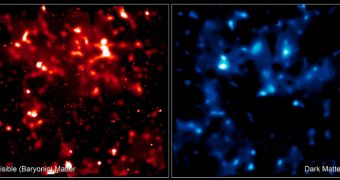Dark matter stars have been proposed to exist for a long time now, but thus far investigators have not been able to discover dark matter, let alone a star made entirely out of the stuff. In a new study, experts propose that finding these cosmic structures is within our current technological capabilities.
What the team suggests is that the glow surrounding some of the earliest stars ever to appear in the Universe may be used as an indicator as to whether their cores are fueled by dark matter or nuclear fusion. The two types of fuels should theoretically produce different types of light.
According to scientists, the light signature of dark matter-powered stars should contain batches of data that are simply not present in their nuclear fusion-powered counterparts. In order to collect large amounts of both types of light, astronomers should point infrared telescopes to the early Universe.
This would ensure that they have access to impressive datasets featuring both types of stars, as they appeared shortly after the Big Bang. Using advanced calculations, the team recently found that dark matter stars should produce sufficient light to be visible in the infrared spectrum.
“Since it is not possible to study star formation in the early universe directly, one relies on the results of numerical simulations,” University of Hamburg astronomers Andreas Maurer and Martin Raue tell Space. They say that this study could help determine which stars were fueled by dark matter.
The mechanism through which dark matter can come to fuel stars is very simple to understand, and starts from the time when compressing hydrogen and helium gases trap it during stellar formation.
The trapped dark matter is then forced to interact with its antimatter, in a process that leads to the formation of electrons, positrons and light particle called photons. Details of the process appear in the February issue of the esteemed Astrophysical Journal.
What the new calculations showed was that the star needs to have only 1 percent dark matter, for this process to take over, and eventually replace nuclear fusion as its main power source. “This additional pressure 'blows up' the star, thereby reducing nuclear fusion,” investigators add.
But undoubtedly one of the most important aspects of this research is the conclusion that dark stars could endure for extensive periods of time, maybe even longer than the Universe itself. Still, this is only conjecture at this point.
“The dark matter densities can be billions of times higher at the center of the galaxy, where stars can capture much more dark matter. Dark stars might be lurking at the center of the galaxy,” says University of Chicago astrophysicist Douglas Spolyar, who was not a part of the study.

 14 DAY TRIAL //
14 DAY TRIAL //